

🌿 What is Palmitoyl Tripeptide-1 & Palmitoyl Tripeptide-7?
Palmitoyl Tripeptide-1 and Palmitoyl Tripeptide-7 are synthetic signal peptides, also known as matrikines, designed to stimulate skin regeneration and suppress inflammation. When paired together, they form a synergistic complex often marketed as Matrixyl™ 3000 one of the most studied and respected peptide technologies in modern skincare.
※ Palmitoyl Tripeptide-1 (Pal-GHK): Mimics the fragment of collagen type I → signals fibroblasts to produce more collagen, elastin, and hyaluronic acid.
※ Palmitoyl Tripeptide-7 (Pal-GQPR): Targets inflammatory cytokines, reducing skin stress and slowing matrix degradation.
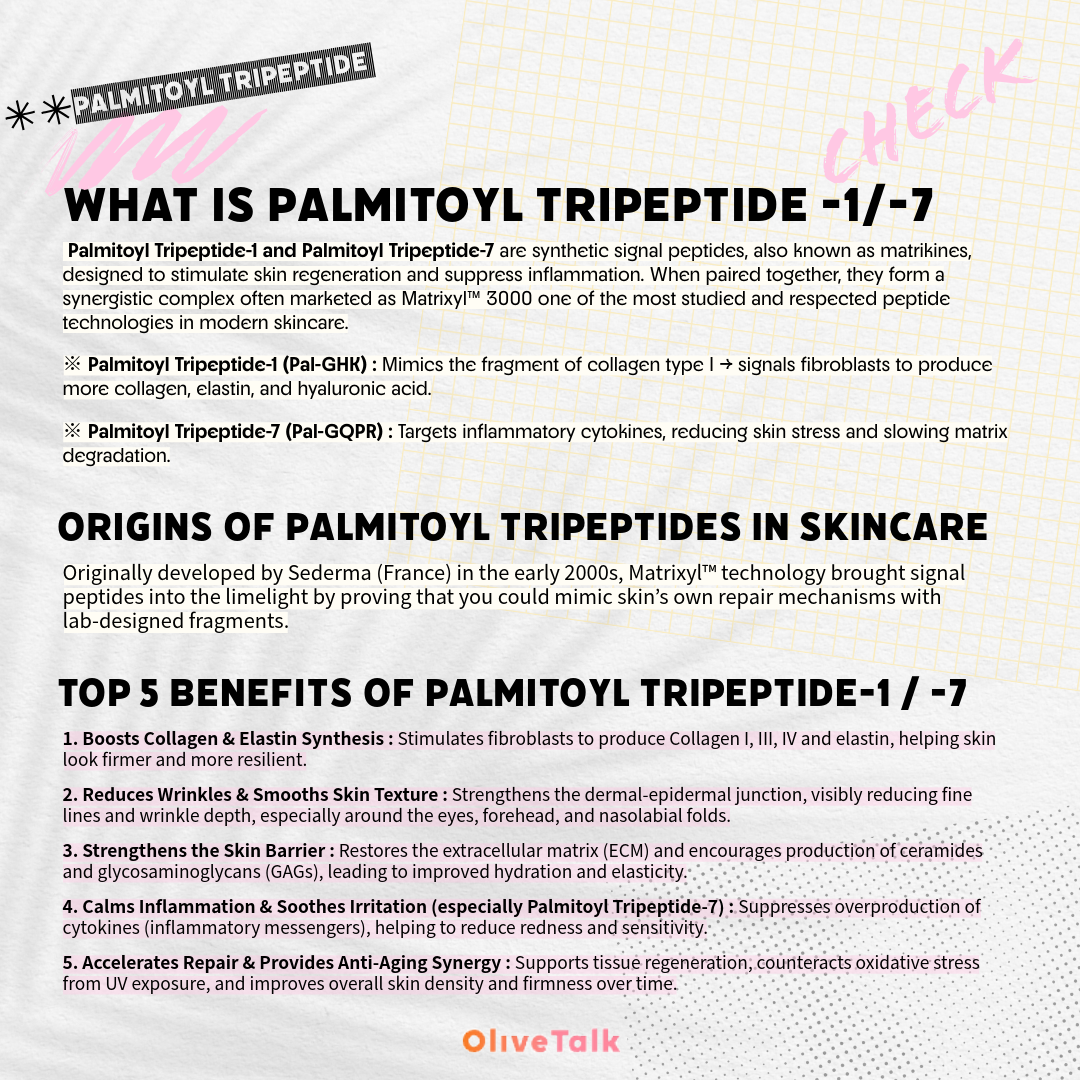
🌱 Origins of Palmitoyl Tripeptides in Skincare
Originally developed by Sederma (France) in the early 2000s, Matrixyl™ technology brought signal peptides into the limelight by proving that you could mimic skin’s own repair mechanisms with lab-designed fragments.
The pairing of Palmitoyl Tripeptide-1 and -7 allowed for a dual-action approach : 1)Trigger new synthesis of dermal support proteins (collagen, elastin, fibronectin), 2)Control inflammation and breakdown by regulating matrix metalloproteinases (MMPs)
🌟 Top 5 Benefits of Palmitoyl Tripeptide-1 / -7
1. Boosts Collagen & Elastin Synthesis
Stimulates fibroblasts to produce Collagen I, III, IV and elastin, helping skin look firmer and more resilient.
2. Reduces Wrinkles & Smooths Skin Texture
Strengthens the dermal-epidermal junction, visibly reducing fine lines and wrinkle depth, especially around the eyes, forehead, and nasolabial folds.
3. Strengthens the Skin Barrier
Restores the extracellular matrix (ECM) and encourages production of ceramides and glycosaminoglycans (GAGs), leading to improved hydration and elasticity.
4. Calms Inflammation & Soothes Irritation (especially Palmitoyl Tripeptide-7)
Suppresses overproduction of cytokines (inflammatory messengers), helping to reduce redness and sensitivity.
5. Accelerates Repair & Provides Anti-Aging Synergy
Supports tissue regeneration, counteracts oxidative stress from UV exposure, and improves overall skin density and firmness over time.
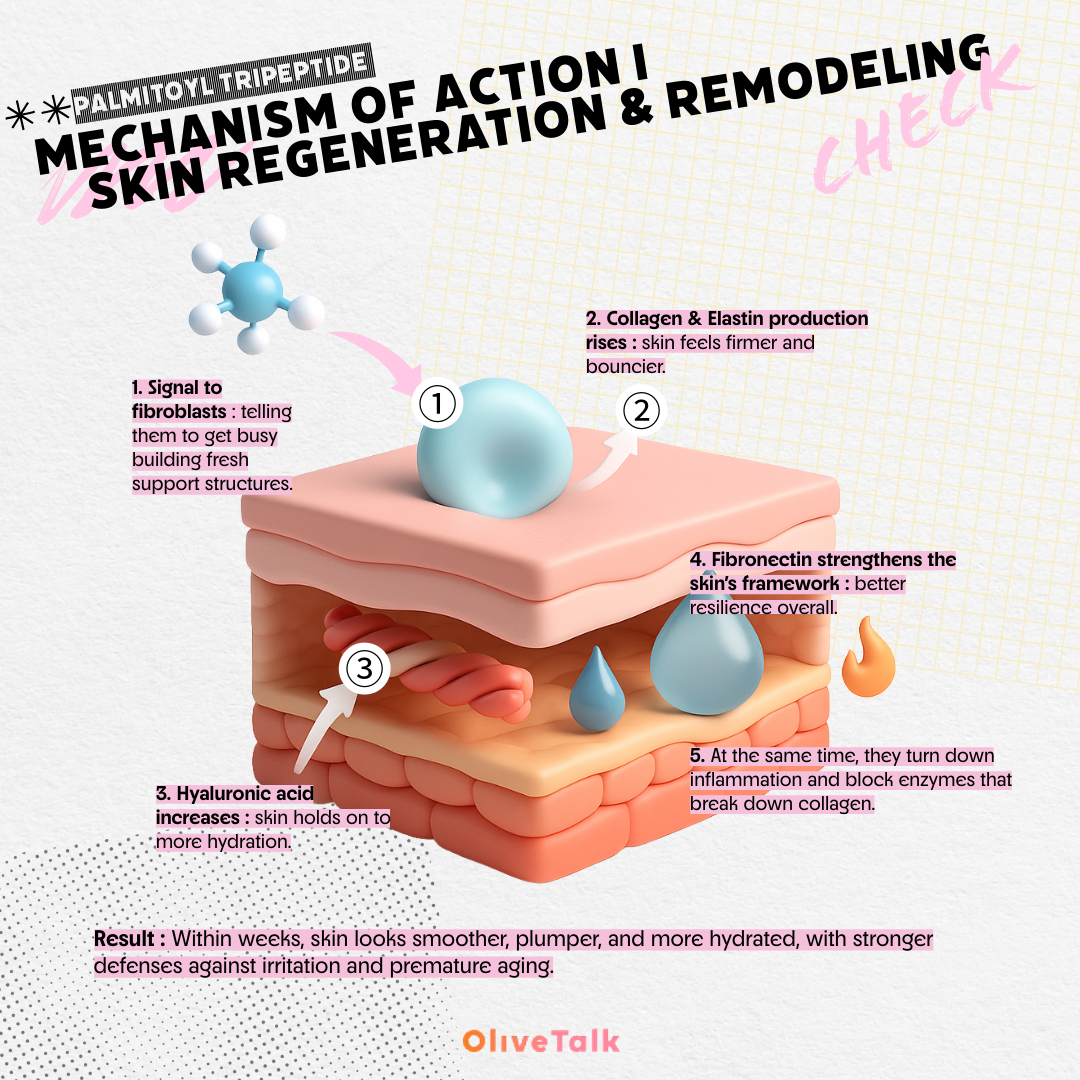
🔬 Mechanism of Action I (Skin Regeneration & Remodeling)
※ Think of these peptides as little messengers that “wake up” your skin cells.
1. Signal to fibroblasts → telling them to get busy building fresh support structures.
2. Collagen & Elastin production rises → skin feels firmer and bouncier.
3. Hyaluronic acid increases → skin holds on to more hydration.
4. Fibronectin strengthens the skin’s framework → better resilience overall.
5. At the same time, they turn down inflammation and block enzymes that break down collagen.
👉 Result : Within weeks, skin looks smoother, plumper, and more hydrated, with stronger defenses against irritation and premature aging.
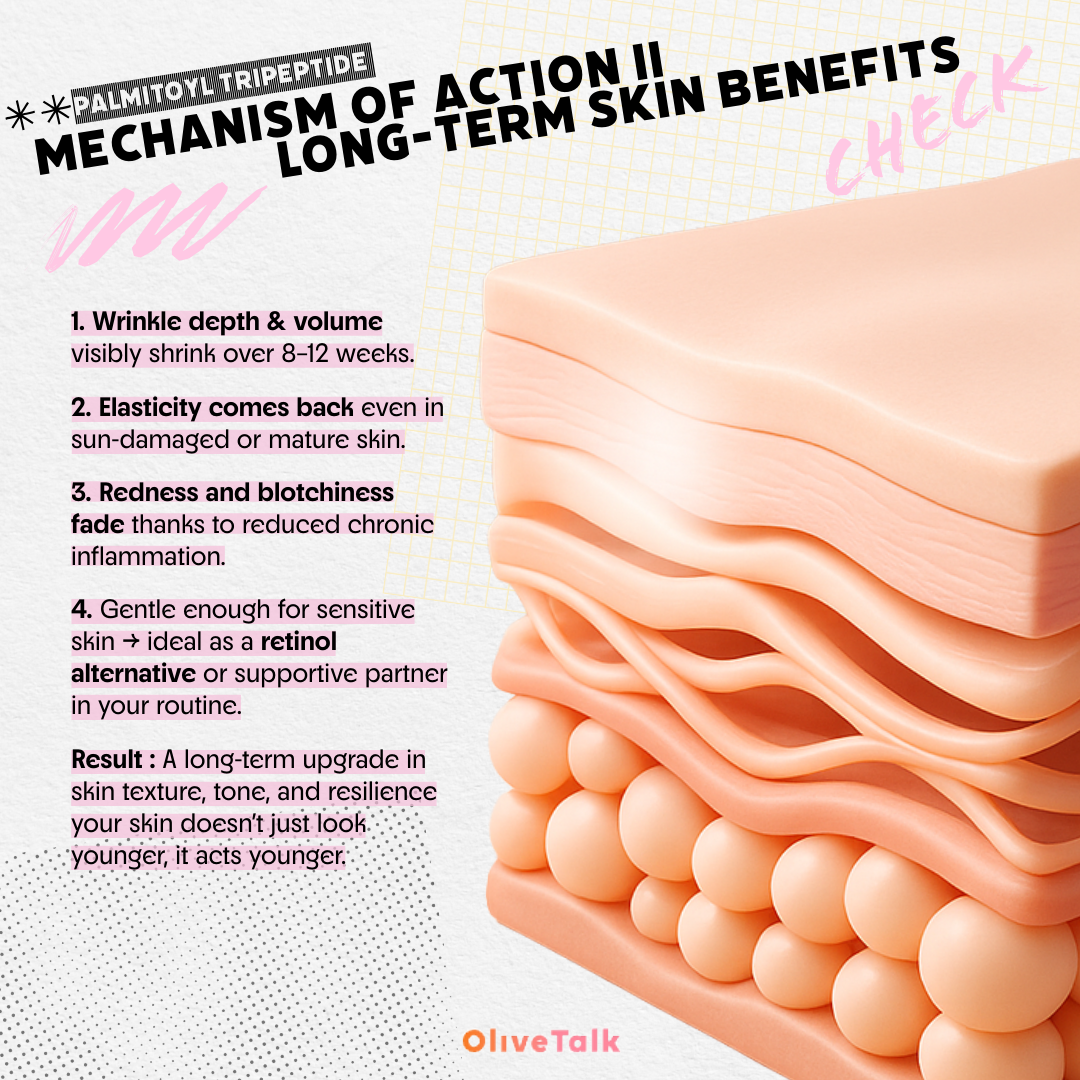
💡 Mechanism of Action II (Long-Term Skin Benefits)
※ Over time, consistency pays off.
1. Wrinkle depth & volume visibly shrink over 8–12 weeks.
2. Elasticity comes back even in sun-damaged or mature skin.
3. Redness and blotchiness fade thanks to reduced chronic inflammation.
4. Gentle enough for sensitive skin → ideal as a retinol alternative or supportive partner in your routine.
👉 Result : A long-term upgrade in skin texture, tone, and resilience your skin doesn’t just look younger, it acts younger.

🔍 Tripeptides vs. Retinol vs. Vitamin C
[Feature / Palmitoyl Tripeptides / Retinol / Vitamin C (L-AA)]
- Collagen Synthesis / ✔✔ / ✔✔✔ / ✔✔
- Inflammation Control / ✔✔ / ✖ (may trigger) / ✔
- Skin Sensitivity / Very low / Moderate–High / Moderate
- Safe for Pregnancy / ✔ / ✖ / ✔ (in moderation)
- Pairing Compatibility / High / Requires buffering / Acid-sensitive
※ Peptides like Pal-GHK and Pal-GQPR are retinol-level effective in long-term collagen building without the irritation, flaking, or sun sensitivity.
🧪 Clinical Evidence & Optimal Concentrations
(Study or Trial / Concentration / Key Findings / Reference)
- Sederma internal (2005) / 3% (Matrixyl 3000) / Wrinkle volume reduced by 33%, skin tone improved by 20% in 8 weeks / Lintner & Peschard (2000)
- Independent placebo trial / 2% / Collagen density increased; wrinkle area reduced in 12 weeks / Robinson et al. (2013)
- In vitro (fibroblast culture) / 1–2% / ↑ Collagen I & III gene expression, ↓ MMP-1 activity / Maquart et al. (1999)
- Split-face clinical trial / 3% / Elasticity and dermal thickness improved in 6–8 weeks / El-Domyati et al. (2015)
- Human skin explant model / 2% / Anti-glycation and anti-inflammatory response confirmed / Draelos et al. (2017)
🧴 Product Formats & Typical Percentages
(Product Type / Typical % Range / Target Benefits)
- Anti-aging Serums / 1–3% (combined) / Firmness, tone, wrinkle reduction
- Eye Creams / 1–2% / Crow’s feet softening, puffiness control
- Barrier Creams / 0.5–1% / Gentle rejuvenation for reactive skin
- Post-retinol Care / 2–3% / Supportive collagen regeneration, barrier relief
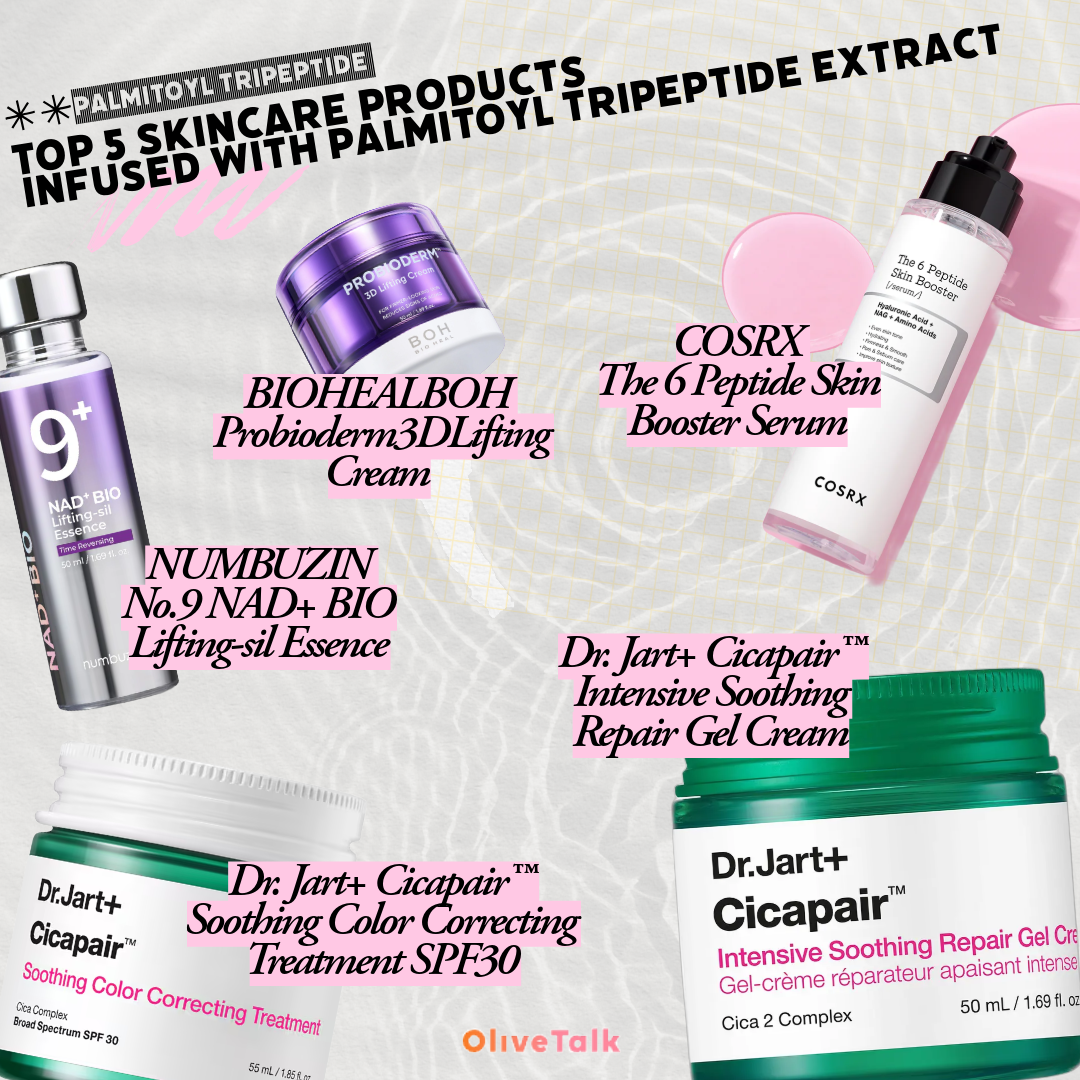
<Top 5 Skincare Products Infused with Palmitoyl Tripeptide Extract>
1. COSRX – The 6 Peptide Skin Booster Serum
Content : no information
Country : KR
2. numbuzin – No.9 NAD+ BIO Lifting‑sil Essence
Content : no information
Country : KR
3. Dr. Jart+ – Cicapair Intensive Soothing Gel Cream
Content : no information
Country : KR
4. Dr. Jart+ – Cicapair Soothing Color Correcting SPF 30
Content : no information
Country : KR
5. BIOHEAL BOH – Probioderm 3D Lifting Cream
Content : no information
Country : KR
🏛️ Historical Note: The Peptide Era Begins
Palmitoyl peptides helped usher in the "non-retinoid anti-aging movement" showing that you could get real, measurable collagen regeneration without inflammation or exfoliation. Over 20 years later, Matrixyl™ remains one of the most clinically validated peptide complexes in skincare.
💾 Final Thoughts from a Skincare Expert
If you’re looking to invest in long-term firming and wrinkle reduction, Palmitoyl Tripeptides-1 and -7 are foundational ingredients. They’re smart, subtle, and steady, delivering better skin quality week after week no peeling, no purging, just performance.
They’re the skincare equivalent of going to the gym for your skin cells results take time, but they’re real and worth it.
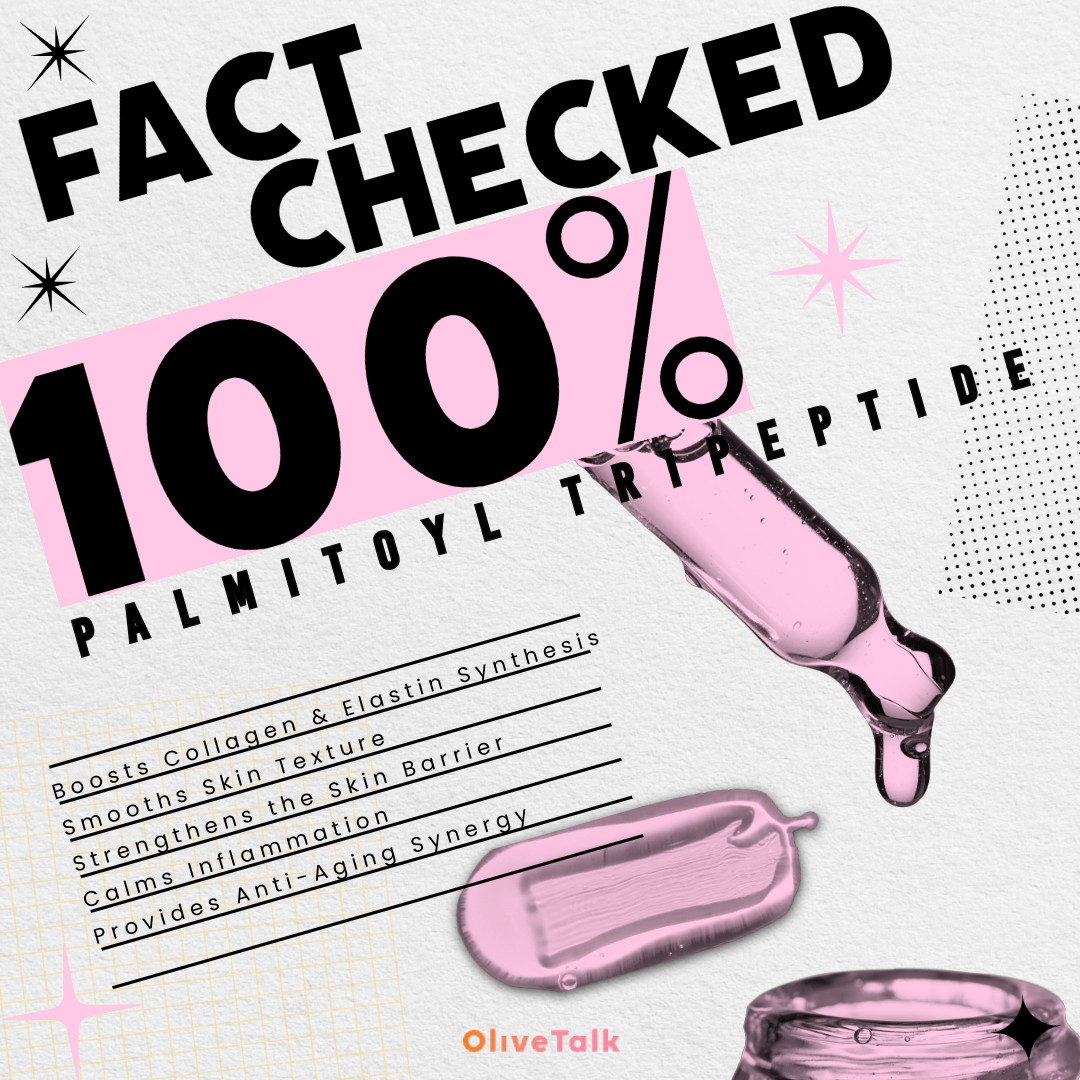
📚 References
Lintner, K., & Peschard, O. (2000). Biologically active peptides: from a laboratory bench curiosity to a functional skin care product. International Journal of Cosmetic Science, 22(3), 207–218.
Robinson, M. K. et al. (2013). A randomized, placebo-controlled study on a peptide complex for wrinkle reduction. Journal of Cosmetic Dermatology, 12(4), 217–224.
Maquart, F. X. et al. (1999). Stimulation of collagen synthesis in fibroblast cultures by Pal-GHK. Cell Biology International, 23(9), 667–673.
El-Domyati, M. et al. (2015). Efficacy of peptide-based creams on skin aging: A split-face trial. Clinical Interventions in Aging, 10, 437–444.
Draelos, Z. D. et al. (2017). Anti-glycation effects of a tripeptide complex in ex vivo human skin. Journal of Drugs in Dermatology, 16(3), 263–268.
Gold, M. H. (2016). Matrixyl 3000: Mechanism and clinical applications. Dermatologic Therapy, 29(1), 15–22.
Poljšak, B. et al. (2013). Aging, oxidative stress and inflammation. Dermato-Endocrinology, 4(3), 278–282.
Guevara, I. L. et al. (2020). Peptides in cosmetics: Structure, function, and clinical potential. Molecules, 25(14), 3254.
 84Comments
84Comments-
 FemaleNormal10 days agoWoww
FemaleNormal10 days agoWoww -
 FemaleCombination10 days agoI love that it works like retinol without irritation
FemaleCombination10 days agoI love that it works like retinol without irritation -
 FemaleNormal10 days agoThe cosrx one is my holy grail fr
FemaleNormal10 days agoThe cosrx one is my holy grail fr FemaleCombination10 days agoSame here. It made my skin better in every aspect
FemaleCombination10 days agoSame here. It made my skin better in every aspect -
 FemaleCombination10 days agoWhy won't brands disclose the concentration????
FemaleCombination10 days agoWhy won't brands disclose the concentration???? FemaleNormal10 days agoFr wish more brands list the % of peptides they use.............. they just say 'peptide complex' all the time
FemaleNormal10 days agoFr wish more brands list the % of peptides they use.............. they just say 'peptide complex' all the time -
 FemaleSensitive10 days agoI'm sensitive to niacinamide but my skin tolerates these peptides so well
FemaleSensitive10 days agoI'm sensitive to niacinamide but my skin tolerates these peptides so well -
 FemaleOily10 days agoLove yr breakdown 🥰🥰
FemaleOily10 days agoLove yr breakdown 🥰🥰 -
 FemaleNormal10 days agoAnyone who tried the biohealboh??
FemaleNormal10 days agoAnyone who tried the biohealboh?? FemaleNormal10 days agoIm also curious
FemaleNormal10 days agoIm also curious -
 FemaleCombination10 days agoNot sure if it is placebo but my skin legit looks smoother when I stick to peptides
FemaleCombination10 days agoNot sure if it is placebo but my skin legit looks smoother when I stick to peptides -
 FemaleNormal10 days agoStill confused if peptides can penetrate deep enough or just works on the surface
FemaleNormal10 days agoStill confused if peptides can penetrate deep enough or just works on the surface FemaleCombination10 days agoSame here
FemaleCombination10 days agoSame here -
 FemaleNormal10 days agoAnyone who tried layering matrixyl with bakuchiol instead of retinol? Curious abt that duo
FemaleNormal10 days agoAnyone who tried layering matrixyl with bakuchiol instead of retinol? Curious abt that duo -
 FemaleSensitive10 days agoNot dramatic but solid
FemaleSensitive10 days agoNot dramatic but solid -
 FemaleOily10 days agoShouldn't expect an overnight effect
FemaleOily10 days agoShouldn't expect an overnight effect -
 FemaleNormal10 days agoPeptides + ceramide combo is the only thing that keeps my skin barrier happy
FemaleNormal10 days agoPeptides + ceramide combo is the only thing that keeps my skin barrier happy FemaleNormal10 days agoLove the combo ❤❤
FemaleNormal10 days agoLove the combo ❤❤ FemaleCombination10 days ago@Female/Normal I come back to the combo every time my skin freaks out
FemaleCombination10 days ago@Female/Normal I come back to the combo every time my skin freaks out FemaleCombination10 days ago@Female/Combination Which ceramide product do u use??
FemaleCombination10 days ago@Female/Combination Which ceramide product do u use?? FemaleCombination10 days ago@Female/Combination Illiyoon ceramic lotion works the most for my skin
FemaleCombination10 days ago@Female/Combination Illiyoon ceramic lotion works the most for my skin FemaleCombination10 days ago@Female/Combination Thx for the response💓
FemaleCombination10 days ago@Female/Combination Thx for the response💓 -
 FemaleNormal10 days agoDeserves more hype than those fancy looking ingredients
FemaleNormal10 days agoDeserves more hype than those fancy looking ingredients FemaleCombination10 days ago100% agree
FemaleCombination10 days ago100% agree FemaleCombination10 days agoFr so underrated
FemaleCombination10 days agoFr so underrated -
 FemaleNormal10 days agoIt does make my skin look plumper
FemaleNormal10 days agoIt does make my skin look plumper -
 FemaleSensitive10 days agoIs it ok to use peptides with exfoliating acids in the same routine?
FemaleSensitive10 days agoIs it ok to use peptides with exfoliating acids in the same routine? FemaleOily10 days agoI actually prefer using peptides after exfoliating. It feels like it absorbs better
FemaleOily10 days agoI actually prefer using peptides after exfoliating. It feels like it absorbs better -
 FemaleNormal10 days agoPeptides worked better on my skin in a serum form than cream
FemaleNormal10 days agoPeptides worked better on my skin in a serum form than cream -
 FemaleNormal10 days agoPeptides wont remove wrinkles but does work as a wrinkle prevention
FemaleNormal10 days agoPeptides wont remove wrinkles but does work as a wrinkle prevention -
 FemaleCombination10 days agoI've been using matrixyl for 3 months and the skin texture got a lot smoother
FemaleCombination10 days agoI've been using matrixyl for 3 months and the skin texture got a lot smoother -
 FemaleNormal10 days agoDoes anyone know if it's better to use it I the morning or at night??
FemaleNormal10 days agoDoes anyone know if it's better to use it I the morning or at night?? FemaleCombination10 days agoI don't use it in the morning. It felt kinda too heavy for morning routine
FemaleCombination10 days agoI don't use it in the morning. It felt kinda too heavy for morning routine FemaleNormal10 days ago@Female/Combination Even in its serum form??
FemaleNormal10 days ago@Female/Combination Even in its serum form?? FemaleCombination10 days ago@Female/Normal I only have cream type
FemaleCombination10 days ago@Female/Normal I only have cream type FemaleNormal10 days ago@Female/Combination I seeeeee thx for answering
FemaleNormal10 days ago@Female/Combination I seeeeee thx for answering -
 FemaleCombination10 days agoCan confirm that my fine lines softened after consistent use
FemaleCombination10 days agoCan confirm that my fine lines softened after consistent use -
 FemaleNormal10 days agoHas anyone tried the Dr.jart gel cream one??
FemaleNormal10 days agoHas anyone tried the Dr.jart gel cream one?? -
 FemaleSensitive10 days agoPeptides product's pride range is quite wild....
FemaleSensitive10 days agoPeptides product's pride range is quite wild.... FemaleOily10 days agoFr😭😭😭
FemaleOily10 days agoFr😭😭😭 -
 FemaleNormal10 days agoHas anyone experienced breakouts from peptidr serums? Just wondering
FemaleNormal10 days agoHas anyone experienced breakouts from peptidr serums? Just wondering FemaleCombination10 days agoAlso curious bc it kinda looked all heavy. Will it clog pores and cause acne on oily skin?
FemaleCombination10 days agoAlso curious bc it kinda looked all heavy. Will it clog pores and cause acne on oily skin? -
 FemaleNormal10 days agoI love pairibg matrixyl with HA
FemaleNormal10 days agoI love pairibg matrixyl with HA FemaleCombination10 days agoSolid combo ever
FemaleCombination10 days agoSolid combo ever -
 FemaleCombination10 days agoIt seems like a good option for sensitive skin types
FemaleCombination10 days agoIt seems like a good option for sensitive skin types -
 FemaleNormal10 days agoMy skin looks less red and irritated since adding peptides to my routine
FemaleNormal10 days agoMy skin looks less red and irritated since adding peptides to my routine -
 FemaleCombination10 days agoThe nunbuzin essence is my holy grail ever. My skin feels more plumped and smooth
FemaleCombination10 days agoThe nunbuzin essence is my holy grail ever. My skin feels more plumped and smooth -
 FemaleNormal10 days agoInteresting 😲😲
FemaleNormal10 days agoInteresting 😲😲 -
 FemaleSensitive10 days agoThx for such a clear and well organized breakdown ✨️😊💞
FemaleSensitive10 days agoThx for such a clear and well organized breakdown ✨️😊💞 -
 FemaleOily9 days agoWhich one is better among those two dr.jart products??
FemaleOily9 days agoWhich one is better among those two dr.jart products?? -
 FemaleNormal9 days agoLove that matrixyl products usually dont irritate
FemaleNormal9 days agoLove that matrixyl products usually dont irritate FemaleCombination9 days agoFr super beginner friendly
FemaleCombination9 days agoFr super beginner friendly -
 FemaleNormal9 days agoDoes anyone know if peptides layer well with vita c?
FemaleNormal9 days agoDoes anyone know if peptides layer well with vita c? -
 FemaleNormal9 days agoCouldn't feel any changes even after using for 3months
FemaleNormal9 days agoCouldn't feel any changes even after using for 3months FemaleCombination9 days agoSame here 😥😥
FemaleCombination9 days agoSame here 😥😥 -
 FemaleCombination9 days agoLove that u also explains the mechanism !!
FemaleCombination9 days agoLove that u also explains the mechanism !! -
 FemaleNormal9 days agoThe cosrx serum is real nice. It pairs well with the cream from the same brand
FemaleNormal9 days agoThe cosrx serum is real nice. It pairs well with the cream from the same brand -
 FemaleOily9 days agoCan I use it with retinol?
FemaleOily9 days agoCan I use it with retinol? FemaleNormal9 days agoGuess that would be too much
FemaleNormal9 days agoGuess that would be too much -
 FemaleSensitive9 days agoIt is great that it has collagen synthesis and inflammation control at the same time
FemaleSensitive9 days agoIt is great that it has collagen synthesis and inflammation control at the same time -
 FemaleNormal9 days agoAn ingredient that has similar effect with retinol but safe during pregnancy??? Sounds great
FemaleNormal9 days agoAn ingredient that has similar effect with retinol but safe during pregnancy??? Sounds great -
 FemaleCombination9 days agoDidn't see much changes at first but photos show gradual improvement
FemaleCombination9 days agoDidn't see much changes at first but photos show gradual improvement -
 FemaleNormal9 days agoWorking both on elasticity and soothing is wild
FemaleNormal9 days agoWorking both on elasticity and soothing is wild -
 FemaleCombination9 days agoSuch an underrated ingredient
FemaleCombination9 days agoSuch an underrated ingredient -
 FemaleNormal9 days agoSounds so new to me 😵💫😵💫😵💫
FemaleNormal9 days agoSounds so new to me 😵💫😵💫😵💫 FemaleSensitive9 days agoMe too. Didn't even know that there's such thing that can replace retinol
FemaleSensitive9 days agoMe too. Didn't even know that there's such thing that can replace retinol -
 FemaleOily9 days agoOoh biohealboh one looks fancy
FemaleOily9 days agoOoh biohealboh one looks fancy -
 FemaleNormal9 days agoWhich product of western brand contains this one?
FemaleNormal9 days agoWhich product of western brand contains this one? -
 FemaleNormal9 days agoWrinkle volume reducing by 33% is wild 😂
FemaleNormal9 days agoWrinkle volume reducing by 33% is wild 😂 -
 FemaleCombination9 days agoDo they have the numbuzin one in Amazon??
FemaleCombination9 days agoDo they have the numbuzin one in Amazon?? -
 FemaleNormal9 days agoConsistency pays off fr
FemaleNormal9 days agoConsistency pays off fr -
 FemaleCombination9 days agoPalmitoyl Tripeptide and ceramide r the best skin barrier protector duo
FemaleCombination9 days agoPalmitoyl Tripeptide and ceramide r the best skin barrier protector duo -
 FemaleNormal9 days agoDidn't even know that vita c also works on collagen synthesis
FemaleNormal9 days agoDidn't even know that vita c also works on collagen synthesis -
 FemaleSensitive9 days agoLearned abt a new ingredient from this post. Thx💞💞
FemaleSensitive9 days agoLearned abt a new ingredient from this post. Thx💞💞 -
 FemaleSensitive9 days agowow this breakdown is super detailed!
FemaleSensitive9 days agowow this breakdown is super detailed! -
 FemaleCombination9 days agoI've been using a serum with Palmitoyl Tripeptide 7 for months and my skin barrier feels stronger
FemaleCombination9 days agoI've been using a serum with Palmitoyl Tripeptide 7 for months and my skin barrier feels stronger -
 FemaleDry9 days agoNot gonna lie, peptides never gave me dramatic results, but maybe i was underdosing?
FemaleDry9 days agoNot gonna lie, peptides never gave me dramatic results, but maybe i was underdosing? -
 FemaleCombination9 days agoAs someone with sensitive skin, i love that these are low irritation compared to retinol
FemaleCombination9 days agoAs someone with sensitive skin, i love that these are low irritation compared to retinol -
 FemaleSensitive9 days agothis is literally the first time I've read peptides explained without marketing fluff. thank you!
FemaleSensitive9 days agothis is literally the first time I've read peptides explained without marketing fluff. thank you! -
 FemaleCombination9 days agoReading this makes me want to layer a peptide serum under my retinol for balance
FemaleCombination9 days agoReading this makes me want to layer a peptide serum under my retinol for balance -
 FemaleCombination9 days agoPeptides and niacinamide has been a game changer combo for my redness
FemaleCombination9 days agoPeptides and niacinamide has been a game changer combo for my redness -
 FemaleDry9 days agoI honestly find peptodrs way overpriced for what they deliever. Retinol just feels stronger to me
FemaleDry9 days agoI honestly find peptodrs way overpriced for what they deliever. Retinol just feels stronger to me -
 FemaleCombination9 days agoI feel like peptides don't get enough hype compared to retinol and vitamin C
FemaleCombination9 days agoI feel like peptides don't get enough hype compared to retinol and vitamin C -
 FemaleDry9 days agoSuper helpful to see the clinical study references includedm makes it feel legit
FemaleDry9 days agoSuper helpful to see the clinical study references includedm makes it feel legit